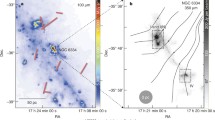Abstract
Current theoretical models for what drives star formation (especially low-mass star formation) are: (1) magnetic support of self-gravitating clouds with ambipolar diffusion removing support in cores and triggering collapse and (2) compressible turbulence forming self-gravitating clumps that collapse as soon as the turbulent cascade produces insufficient turbulent support. Observations of magnetic fields can distinguish between these two models because of different predictions in three areas: (1) magnetic field morphology, (2) the scaling of field strength with density and non-thermal velocities, and (3) the mass to magnetic flux ratio, M/Φ. We first discuss the techniques and limitations of methods for observing magnetic fields in star formation regions, then describe results for the L1544 prestellar core as an exemplar of the observational results. Application of the three tests leads to the following conclusions. The observational data show that both magnetic fields and turbulence are important in molecular cloud physics. Field lines are generally regular rather than chaotic, implying strong field strengths. But fields are not aligned with the minor axes of oblate spheroidal clouds, suggesting that turbulence is important. Field strengths appear to scale with non-thermal velocity widths, suggesting a significant turbulent support of clouds. Giant Molecular Clouds (GMCs) require mass accumulation over sufficiently large volumes that they would likely have an approximately critical M/Φ. Yet H I clouds are observed to be highly subcritical. If self-gravitating (molecular) clouds form with the subcritical M/Φ of H I clouds, the molecular clouds will be subcritical. However, the observations of molecular cloud cores suggest that they are approximately critical, with no direct evidence for subcritical molecular clouds or cloud envelopes. Hence, the observations remain inconclusive in deciding between the two extreme-case models of what drives star formation. What is needed to further advance our understanding of the role of magnetic fields in the star formation process are additional high sensitivity surveys of magnetic field strengths and other cloud properties in order to further refine the assessment of the importance of magnetic fields in molecular cores and envelopes.
Similar content being viewed by others
References
Ballesteros-Paredes, J. and MacLow, M.-M.: 2002, ApJ 570, 734.
Balsara, D., Ward-Thompson, D. and Crutcher, R.M.: 2001, MNRAS 327, 715.
Basu, S.: 2000, ApJ 540, L103.
Bourke, T.L., Myers, P.C., Robinson, G. and Hyland, A.R.: 2001, ApJ 554, 916.
Caselli, P., Benson, P.J., Myers, P.C. and Tafalla, M.: 2002, ApJ 572, 238.
Chandrasekhar, S. and Fermi, E.: 1953, ApJ 118, 113.
Ciolek, G.E. and Basu, S.: 2000, ApJ 529, 925.
Crutcher, R.M., Troland, T.H., Goodman, A.A., Heiles, C., Kazès, I. and Myers, P.C.: 1993, ApJ 407, 175.
Crutcher, R.M.: 1999, ApJ 520, 706.
Crutcher, R.M. and Troland, T.H.: 2000, ApJ 537, L139.
Crutcher, R.M., Nutter, D., Ward-Thompson, D. and Kirk, J.M.: 2004, ApJ 600, 279.
Gammie, C.F., Lin, Y.-T., Stone, J.M. and Ostriker, E.C.: 2003, ApJ 592, 203.
Girart, J.M., Crutcher, R.M. and Rao, R.: 1999, ApJ 525, L169.
Hartmann, L., Ballesteros-Paredes, J. and Bergin, E.A.: 2001, ApJ 562, 852.
Heiles, C.: 2004, Ap&SS 292, 77.
Heitsch, F., Zweibel, E.G., MacLow, M.-M., Li, P.S. and Norman, M.L.: 2001, ApJ 561, 800.
Kylafis, N.D.: 1983, ApJ 275, 135.
Lazarian, A.: 2003, JQSRT 79, 881.
Matthews, B.C. and Wilson, C.D.: 2002, ApJ 531, 868.
Mouschovias, T.Ch.: 1976, ApJ 207, 141.
Mouschovias, T.Ch. and Spitzer, L.: 1976, ApJ 210, 326.
Mouschovias, T.Ch. and Ciolek, G.E.: 1999, in: C.J. Lada and N.D. Kylafis (eds.), The Origin of Stars and Planetary Systems Kluwer Academic Publishers, Dordrecht, p. 305.
Nakano, T. and Nakamura, T.: 1978, PASJ 30, 681.
Nakano, T.: 1984, Fund. Cosmic Phys. 9, 139.
Ostriker, E.C., Stone, J.M. and Gammie, C.F.: 2001, ApJ 546, 980.
Padoan, P. and Nordlund, Å. 1999, ApJ 526, 279.
Padoan, P., Goodman, A., Draine, B.T., Juvela, M., Nordlund, Å. and Rögnvaldsson, Ö.E.: 2001, ApJ 559, 1005.
Passot, T. and Vázquez-Semadeni, E.: 2003, A&A 398, 845.
Roberts, D., Crutcher, R.M., Troland, T.H. and Goss, W.M.: 1993, ApJ 412, 675.
Schleuning, D.A.: 1998, ApJ 493, 811.
Shu, F.H., Adams, F.C. and Lizano, S.: 1987, ARA&A 25, 23.
Tafalla, M., Mardones, D., Myers, P.C., Caselli, P., Bachiller, R. and Benson, P.J.: 1998, ApJ 504, 900.
Troland, T.H. and Heiles, C.: 1986, ApJ 301, 339.
Troland, T.H. and Crutcher, R.M.: 2004, submitted.
Ward-Thompson, D., Kirk, J.M., Crutcher, R.M., Greaves, J.S., Holland, W.S. and Andrá, P.: 2000, ApJ 537, L135.
Williams, J.P., Myers, P.C., Wilner, D.J. and Di Francesco, J.: 1999, ApJ 513, L61.
Author information
Authors and Affiliations
Rights and permissions
About this article
Cite this article
Crutcher, R.M. What Drives Star Formation?. Astrophysics and Space Science 292, 225–237 (2004). https://doi.org/10.1023/B:ASTR.0000045021.42255.95
Issue Date:
DOI: https://doi.org/10.1023/B:ASTR.0000045021.42255.95




